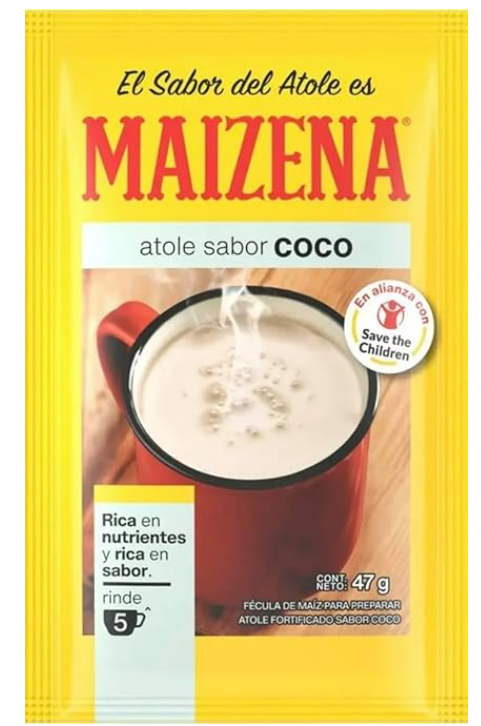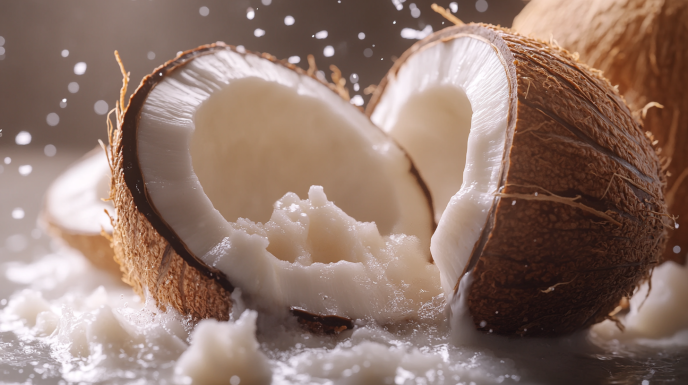
Maizena sabor coco 47g coconut flavor 6 pk
- Maizena sabor coco 47g coconut flavor 6 pk
Discovering the Silky, Tropical Elixir That Warms Both Body and Soul
In the misty mornings of Caribbean kitchens, when the roosters have just begun to crow and the day stretches ahead like a blank canvas, there exists a ritual as old as time itself. Hands move almost by memory, measuring coconut milk, stirring cornstarch, and adding just the right touch of sweetness to create what generations have known as comfort in a cup: Maizena de Coco.
The first time I tasted this silky, warm beverage, I was visiting my friend’s grandmother in Puerto Rico. She served it in a chipped porcelain cup that had clearly witnessed decades of family gatherings. One sip, and I understood why this humble drink had endured through generations. There was something almost magical about how the velvety texture coated my tongue, how the gentle sweetness didn’t overwhelm but rather enhanced the tropical essence of coconut.
Maizena de Coco isn’t just a beverage—it’s a cultural touchstone, a liquid heirloom passed down through whispered kitchen conversations and handwritten recipe cards tucked into cookbooks.
But what exactly is this treasured concoction, and why does it hold such a special place in the hearts of so many? Let’s embark on a journey to explore the world of Maizena de Coco—its origins, preparation, variations, and the comfort it continues to bring to kitchens worldwide.
What Is Maizena de Coco?
At its essence, Maizena de Coco is a traditional beverage made primarily from coconut milk thickened with cornstarch (known as “maizena” in many Spanish-speaking regions). This creates a luxuriously smooth, pudding-like drink that can be enjoyed hot or cold, depending on preference and climate.
The name itself reveals its lineage—”Maizena” is the brand name for cornstarch that became so ubiquitous in Latin American countries that it turned into the generic term for the product itself, similar to how “Kleenex” is often used for any facial tissue. “Coco,” of course, refers to the coconut, the star ingredient that gives this beverage its distinctive tropical character.
While it shares similarities with other cornstarch-based drinks like atole (a traditional Mexican hot beverage), Maizena de Coco distinguishes itself through its use of coconut milk as the primary liquid base rather than dairy milk or water. This seemingly simple substitution transforms the beverage entirely, creating something that feels simultaneously familiar and exotic.
The drink traces its roots to the Caribbean islands where coconut palms grow abundantly, and resourceful cooks learned to utilize every part of this versatile fruit. Over time, it spread throughout Latin America and beyond, each region adding its own distinctive flair while maintaining the fundamental elements that make Maizena de Coco so beloved.
The Heart and Soul of Maizena de Coco: Essential Ingredients
Like many traditional recipes, Maizena de Coco’s beauty lies in its simplicity. At its most basic, you need only three ingredients:
- Coconut milk
- Cornstarch (Maizena)
- Sweetener (traditionally sugar, but more on alternatives later)
Yet within this simplicity lies infinite possibility for personalization. The quality and type of coconut milk, the amount of cornstarch, the choice of sweetener, and additional flavorings all contribute to creating a version that feels uniquely yours.
Coconut Milk: The Foundation
The soul of any good Maizena de Coco is undoubtedly the coconut milk. While canned varieties offer convenience and consistent results, there’s something profoundly satisfying about making your own fresh coconut milk from mature coconuts.
If you’re fortunate enough to have access to fresh coconuts, the process of creating your own milk involves grating the white flesh, combining it with hot water, and then straining the mixture through cheesecloth. The resulting liquid carries a freshness and complexity of flavor that commercial versions can rarely match. The first pressing yields a rich, thick cream that’s perfect for Maizena de Coco, while subsequent pressings provide a lighter milk that can be used for other purposes.
For those relying on canned coconut milk, quality matters tremendously. Look for varieties with minimal additives—ideally just coconut and water. The thickness can vary significantly between brands, so you might need to adjust the amount of cornstarch accordingly. Full-fat versions produce the most luxurious texture, but light coconut milk works well for those monitoring calorie intake.
Cornstarch: The Magical Thickener
Cornstarch serves as the binding agent that transforms liquid coconut milk into a velvety embrace. The fine white powder might seem unassuming, but its ability to thicken liquids when heated makes it indispensable in countless culinary applications.
The ratio of cornstarch to coconut milk determines the final consistency of your Maizena de Coco. Some prefer it relatively thin, almost like a rich hot beverage, while others enjoy it thick enough that a spoon stands upright—closer to pudding than drink. This is entirely a matter of personal preference, and part of the joy of making this recipe your own is discovering exactly how you like it.
Sweeteners: Finding the Perfect Balance
Traditionally, white sugar serves as the sweetener in Maizena de Coco, but this is perhaps the ingredient with the most room for creative interpretation. Brown sugar adds molasses notes that complement the coconut beautifully. Honey contributes floral undertones. Maple syrup brings woodsy warmth. Coconut sugar creates a caramel-like depth while reinforcing the coconut flavor.
For those avoiding refined sugars, options like stevia, monk fruit extract, or erythritol can work, though they may alter the final taste slightly. The key is finding a balance where the sweetener enhances rather than overshadows the delicate coconut flavor.
Crafting the Perfect Maizena de Coco: A Step-by-Step Guide
Now that we understand the building blocks, let’s walk through the process of creating this beloved beverage in your own kitchen. While the basic technique remains constant, remember that this is a forgiving recipe that welcomes adaptation.
Traditional Maizena de Coco Recipe
Ingredients:
- 2 cups coconut milk (canned or fresh)
- 2-3 tablespoons cornstarch (Maizena)
- 3-4 tablespoons sugar (adjust to taste)
- 1 cinnamon stick or ¼ teaspoon ground cinnamon
- ¼ teaspoon vanilla extract (optional)
- Pinch of salt
Instructions:
- In a small bowl, dissolve the cornstarch in ¼ cup of the coconut milk, stirring until completely smooth. This crucial step prevents lumps from forming later. Think of it as creating a slurry that will incorporate seamlessly into the hot liquid.
- In a medium saucepan, combine the remaining coconut milk, sugar, cinnamon stick, and pinch of salt. Heat over medium-low heat, stirring occasionally to dissolve the sugar.
- When the mixture begins to steam (but before it boils), remove the cinnamon stick and slowly pour in the cornstarch slurry while whisking constantly.
- Continue to cook, whisking frequently, as the mixture thickens. This typically takes 3-5 minutes. You’ll notice the texture changing, becoming more viscous as the cornstarch activates in the heat.
- Once the mixture reaches your desired consistency—anywhere from thick cream to pudding-like—remove from heat and stir in the vanilla extract if using.
- Serve immediately in mugs or cups, perhaps with a sprinkle of ground cinnamon on top for extra aroma and visual appeal.
The beauty of this process lies in its gentle rhythm. There’s something meditative about standing at the stove, whisking slowly as the mixture transforms before your eyes. It’s one of those recipes where the preparation itself becomes part of the pleasure.
Troubleshooting Common Challenges
Even with such a straightforward recipe, occasional hiccups can occur. Here’s how to address the most common issues:
Lumpy Texture: The most frequent complaint when making Maizena de Coco is ending up with a lumpy final product. This almost always stems from adding the cornstarch directly to hot liquid. Always create a slurry with cold or room temperature liquid first, then introduce it to the hot mixture while whisking vigorously.
Too Thick or Too Thin: If your Maizena de Coco thickens more than desired, simply whisk in additional coconut milk until you reach your preferred consistency. Conversely, if it’s too thin, you can create another small cornstarch slurry and add it incrementally while the mixture is still hot.
Scorched Bottom: This beverage requires attention as it cooks. If you walk away or heat it too aggressively, the bottom can scorch, imparting a burnt flavor throughout. Use moderate heat and stir frequently, making sure to scrape the bottom of the pan with your whisk or spoon.
Skin Formation When Cooling: Like many milk-based preparations, Maizena de Coco can develop a skin on top as it cools. To prevent this, either serve immediately or place a piece of plastic wrap directly on the surface while cooling.
Beyond the Basics: Creative Variations to Explore
While the traditional recipe holds an enduring charm, Maizena de Coco invites experimentation. Here are some variations that honor the original while introducing new dimensions of flavor:
Spice Infusions
The addition of spices can transform Maizena de Coco into something even more extraordinary. Consider these options:
- Cinnamon-Star Anise: Add a star anise pod alongside the cinnamon stick during heating for a complex, slightly licorice-tinged flavor profile.
- Cardamom-Clove: Crush 2-3 cardamom pods and add with a single clove for an aromatic variation reminiscent of chai.
- Ginger-Nutmeg: Add a thin slice of fresh ginger during heating and finish with a sprinkle of freshly grated nutmeg for a warming, spicy version perfect for cold evenings.
Flavor Additions
Beyond spices, consider these flavor enhancers:
- Chocolate Maizena de Coco: Add 1-2 tablespoons of cocoa powder or grated dark chocolate for a tropical hot chocolate effect.
- Coffee Infused: Replace ¼ cup of the coconut milk with strong brewed coffee for a subtle mocha undertone.
- Citrus Zest: The addition of orange, lime, or lemon zest (about ½ teaspoon) brings a bright, aromatic quality that cuts through the richness.
Textural Elements
For those who enjoy contrasting textures, consider these additions just before serving:
- Toasted Coconut Flakes: Sprinkle toasted unsweetened coconut flakes on top for a crunchy contrast.
- Chia Seeds: A teaspoon of chia seeds adds nutritional value and an interesting texture.
- Crushed Cookies: For an indulgent dessert version, serve with crushed vanilla wafers or cinnamon cookies on top.
The Nutritional Profile: Understanding What’s in Your Cup
As with any food or beverage, understanding the nutritional aspects of Maizena de Coco can help you enjoy it mindfully. While not typically consumed for its nutritional benefits, it does offer some positive attributes alongside considerations for those monitoring specific dietary factors.
Caloric Content
A typical serving of traditional Maizena de Coco (about 8 ounces) contains approximately 250-350 calories, depending on the exact ingredients used. The majority of these calories come from the coconut milk, which is naturally high in fats—primarily saturated fats.
For a lighter version, using light coconut milk can reduce the calorie content to around 150-200 calories per serving, though this comes with a corresponding reduction in creaminess and mouthfeel.
Dietary Considerations
Dairy-Free: One of the inherent benefits of Maizena de Coco is that it’s naturally dairy-free, making it suitable for those with lactose intolerance or milk allergies. This dairy-free status has contributed to its rising popularity in Western countries where dairy alternatives are increasingly sought after.
Gluten-Free: Pure cornstarch is gluten-free, making Maizena de Coco an excellent option for those with celiac disease or gluten sensitivity. However, always check the packaging of your cornstarch to ensure it hasn’t been processed in facilities that also handle wheat products.
Vegan Status: The traditional recipe is naturally vegan, as it contains no animal products. If modifications are made (such as adding honey as a sweetener), this status would change, but the core recipe aligns with vegan dietary guidelines.
Nutritional Benefits
While Maizena de Coco is primarily enjoyed as a comforting treat rather than a health food, it does offer some nutritional benefits:
- Medium-Chain Triglycerides (MCTs): Coconut milk contains MCTs, which are fats that may be metabolized differently than other saturated fats, potentially providing quick energy rather than being stored.
- Minerals: Coconut milk provides small amounts of minerals including iron, magnesium, and potassium.
- Easily Digestible: For those with sensitive stomachs, the simple ingredient list and cooking process make Maizena de Coco generally easy to digest.
It’s worth noting that these benefits should be viewed in the context of the overall nutritional profile, which is relatively high in calories and saturated fat. Like many traditional comfort foods, Maizena de Coco is best enjoyed as an occasional treat rather than a daily staple for most people.
Cultural Significance: More Than Just a Beverage
To truly appreciate Maizena de Coco, we must consider its place within the broader cultural context. This isn’t merely a recipe—it’s a vessel for memories, traditions, and shared experiences.
Regional Variations and Local Significance
Throughout the Caribbean and Latin America, you’ll find countless regional interpretations of this basic concept:
In Puerto Rico, Maizena de Coco often appears as a breakfast item or afternoon pick-me-up, sometimes enhanced with a splash of rum for adults during festive occasions.
Dominican variations might include evaporated milk alongside the coconut milk, creating an even richer texture and flavor profile.
In coastal regions of Colombia, it’s frequently served as a restorative beverage, offered to those recovering from illness or to new mothers during the postpartum period.
Cuban versions often emphasize the cinnamon aspect, sometimes incorporating a cinnamon-sugar mixture called “canela” that’s sprinkled generously on top.
Each of these variations reflects the specific cultural context, available ingredients, and historical influences of the region, while maintaining the core elements that make Maizena de Coco universally recognizable.
Occasions and Traditions
Certain occasions have become particularly associated with Maizena de Coco consumption:
Morning Ritual: In many households, preparing Maizena de Coco marks the beginning of the day, especially during cooler months or rainy seasons when its warming properties are most appreciated.
Celebration of New Life: The nutritive properties of coconut milk have led to traditions of serving Maizena de Coco to new mothers and to family members gathered to welcome a new baby.
Holiday Gatherings: During Christmas and New Year celebrations in many Caribbean countries, Maizena de Coco appears alongside more complex holiday dishes, offering a simple but beloved counterpoint to elaborate feast foods.
Comfort During Illness: Like chicken soup in other cultures, Maizena de Coco is often prepared for family members fighting colds, flu, or other ailments, believed to provide both nutrition and comfort during recovery.
Pairing Suggestions: Complementary Flavors and Occasions
While delightful on its own, Maizena de Coco pairs beautifully with various foods and can enhance specific moments when thoughtfully presented.
Ideal Food Pairings
Crisp Cookies: The contrast between the smooth, creamy beverage and crisp, crunchy cookies creates a perfect textural balance. Consider simple butter cookies, coconut tuiles, or even shortbread.
Fresh Tropical Fruits: Slices of mango, pineapple, or banana offer a fresh counterpoint to the rich beverage, creating a complete tropical experience.
Toast and Quick Breads: Cinnamon toast, banana bread, or coconut bread complement the flavors while creating a more substantial snack or breakfast.
Savory Cheese: For an unexpected but delightful pairing, try serving Maizena de Coco alongside a mild white cheese like queso fresco or farmer’s cheese. The contrast between sweet and savory creates an intriguing tasting experience.
Occasion-Based Serving Suggestions
Rainy Day Comfort: Serve in oversized mugs alongside a good book for the ultimate cozy experience during inclement weather.
Elegant Dessert Alternative: For dinner parties, serve chilled Maizena de Coco in small, elegant glasses topped with a sprinkle of cinnamon and perhaps a small cookie for an unexpected dessert option.
Breakfast in Bed: The make-ahead potential (simply reheat gently) makes this an ideal component of a special breakfast in bed, perhaps for Mother’s Day or anniversaries.
Late-Night Soother: The combination of gentle sweetness and warm comfort makes Maizena de Coco an excellent before-bed beverage, potentially aiding in relaxation and sleep.
Preserving and Repurposing: Making the Most of Your Maizena de Coco
While best enjoyed fresh, practical considerations sometimes require storage or creative repurposing of leftovers.
Storage Guidelines
If you’ve made more Maizena de Coco than can be consumed immediately, proper storage is essential:
Refrigeration: Transfer cooled Maizena de Coco to an airtight container. Place plastic wrap directly on the surface to prevent skin formation, then seal with a lid. Refrigerated, it will keep for 2-3 days.
Reheating: Gentle heat is crucial when reheating. Use a saucepan over low heat, stirring constantly, or microwave in short intervals, stirring between each. You may need to add a splash of coconut milk to restore the original consistency.
Freezing: While not ideal due to potential texture changes upon thawing, Maizena de Coco can be frozen in individual portions for up to a month. Thaw overnight in the refrigerator before gently reheating.
Creative Repurposing
Leftover Maizena de Coco need not go to waste—consider these creative ways to transform it:
Coconut Pudding: Add a bit more cornstarch while reheating to create a spoonable dessert pudding. Pour into individual serving dishes and chill until set.
Frozen Treats: Pour into popsicle molds and freeze for a unique frozen dessert, particularly appealing in summer months.
Cake Filling: Thick Maizena de Coco can serve as an unexpected filling between cake layers, offering a tropical twist to conventional layer cakes.
Smoothie Base: Blend chilled Maizena de Coco with fresh fruit for a thick, luxurious breakfast smoothie with added staying power.
Conclusion: The Enduring Charm of Simplicity
In our complex culinary landscape, where elaborate techniques and exotic ingredients often take center stage, there’s something profoundly reassuring about returning to fundamentals. Maizena de Coco reminds us that true culinary magic can emerge from the simplest combinations—coconut, cornstarch, sweetness—transformed through careful attention and cultural knowledge.
What begins as a handful of humble ingredients becomes something greater: a carrier of memory, a vessel for tradition, a moment of comfort in liquid form. Whether you’re discovering it for the first time or reconnecting with a childhood favorite, Maizena de Coco offers an accessible entry point into the rich culinary traditions of the Caribbean and Latin America.
Perhaps its greatest gift is its adaptability—the way it can be precisely what you need it to be. A warming breakfast on a chilly morning. A cooling afternoon refreshment in tropical heat. A gentle digestive after a spicy meal. A sweet comfort during illness. It shape-shifts to fit the moment while remaining fundamentally itself.
As you create your own version in your kitchen, remember that you’re participating in a tradition that spans generations and geography. Each stir of the spoon connects you to countless others who have found comfort in this simple pleasure.
In a world that often prizes complexity, Maizena de Coco stands as a testament to the power of simplicity—reminding us that sometimes, the most profound culinary experiences come from the most basic elements, transformed through care, tradition, and love.






